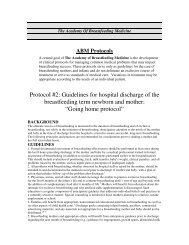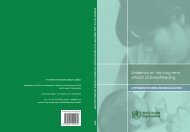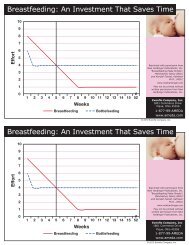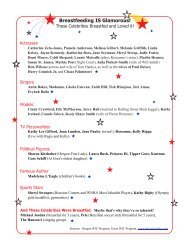Congenital Tongue-Tie and Its Impact on Breastfeeding - New ...
Congenital Tongue-Tie and Its Impact on Breastfeeding - New ...
Congenital Tongue-Tie and Its Impact on Breastfeeding - New ...
You also want an ePaper? Increase the reach of your titles
YUMPU automatically turns print PDFs into web optimized ePapers that Google loves.
Page 2<strong>Breastfeeding</strong>: Best for Baby <str<strong>on</strong>g>and</str<strong>on</strong>g> MotherThe American Academy of Pediatrics (AAP)offers the <strong>Breastfeeding</strong>: Best for Baby <str<strong>on</strong>g>and</str<strong>on</strong>g> Mothernewsletter as a member benefit of the AAPSecti<strong>on</strong> <strong>on</strong> <strong>Breastfeeding</strong>. Informati<strong>on</strong> about theAAP <strong>Breastfeeding</strong> Promoti<strong>on</strong> in Physicians’Office Practices (BPPOP-Phase II) program alsois included. The newsletter is intended as a forumfor sharing informati<strong>on</strong> about breastfeeding<str<strong>on</strong>g>and</str<strong>on</strong>g> AAP breastfeeding initiatives to facilitatenetworking am<strong>on</strong>g AAP members. The AAPprovides this newsletter through its Departmentof Community Pediatrics Divisi<strong>on</strong> of CommunityHealth Services.Comments <str<strong>on</strong>g>and</str<strong>on</strong>g> questi<strong>on</strong>s are welcome <str<strong>on</strong>g>and</str<strong>on</strong>g> canbe directed to:American Academy of PediatricsDivisi<strong>on</strong> of Community Health Services141 Northwest Point BlvdElk Grove Village, IL 60007-1098Ph<strong>on</strong>e: 800/433-9016, ext 7821Fax: 847/434-8000E-mail: lactati<strong>on</strong>@aap.orgWeb site: www.aap.orgAAP StaffBetty Crase, IBCLC, RLC, ManagerCyndy Rouse, Divisi<strong>on</strong> AssistantThomas F. T<strong>on</strong>niges, MD, Director, Departmentof Community Pediatrics<strong>New</strong>sletter EditorNancy Powers, MDChairpers<strong>on</strong>, Communicati<strong>on</strong>s CommitteeAAP Secti<strong>on</strong> <strong>on</strong> <strong>Breastfeeding</strong>AAP Chapter <strong>Breastfeeding</strong> Coordinator, KansasElectr<strong>on</strong>ic mailing lists are available for AAP Chapter<strong>Breastfeeding</strong> Coordinators, members of theBPPOP-Phase II program, <str<strong>on</strong>g>and</str<strong>on</strong>g> members of the AAPSecti<strong>on</strong> <strong>on</strong> <strong>Breastfeeding</strong>. C<strong>on</strong>tact program staff forinformati<strong>on</strong> regarding participati<strong>on</strong>.The recommendati<strong>on</strong>s listed in this newsletter <str<strong>on</strong>g>and</str<strong>on</strong>g>in the menti<strong>on</strong>ed publicati<strong>on</strong>s do no indicate anexclusive course of treatment or serve as a st<str<strong>on</strong>g>and</str<strong>on</strong>g>ardof medical care. Variati<strong>on</strong>s, taking into accountindividual circumstances, may be appropriate. Thisnewsletter <str<strong>on</strong>g>and</str<strong>on</strong>g> the materials menti<strong>on</strong>ed within thisnewsletter discuss titles published by organizati<strong>on</strong>sother than the American Academy of Pediatrics.Statements <str<strong>on</strong>g>and</str<strong>on</strong>g> opini<strong>on</strong>s expressed in these publicati<strong>on</strong>sare those of the authors <str<strong>on</strong>g>and</str<strong>on</strong>g> not necessarilythose of the American Academy of Pediatrics.Any part of this newsletter may be reproduced forn<strong>on</strong>commercial educati<strong>on</strong>al purposes.© 2004 American Academy of PediatricsCONGENTIAL TONGUE-TIE [CONTINUED FROM P 1]© 2004 Catherine W Genna © 2004 Catherine W GennaClassicmiddle of the floor of the mouth <str<strong>on</strong>g>and</str<strong>on</strong>g> is usuallytighter <str<strong>on</strong>g>and</str<strong>on</strong>g> less elastic.Type 4 is essentially against the base of the t<strong>on</strong>gue,<str<strong>on</strong>g>and</str<strong>on</strong>g> is thick, shiny <str<strong>on</strong>g>and</str<strong>on</strong>g> very inelastic.SimpleClassic heart shaped t<strong>on</strong>gue caused by restricted central t<strong>on</strong>gue tip elevati<strong>on</strong>. This presentati<strong>on</strong> is actuallysometimes less symptomatic than the tighter, shorter frenula that present as flattened (simple) or bunchedt<strong>on</strong>gue .Types 1 <str<strong>on</strong>g>and</str<strong>on</strong>g> 2, c<strong>on</strong>sidered “classical” t<strong>on</strong>gue-tie,are the most comm<strong>on</strong> <str<strong>on</strong>g>and</str<strong>on</strong>g> obvious t<strong>on</strong>gue-ties, <str<strong>on</strong>g>and</str<strong>on</strong>g>probably account for 75% of incidence. Types 3 <str<strong>on</strong>g>and</str<strong>on</strong>g>4 are less comm<strong>on</strong>, <str<strong>on</strong>g>and</str<strong>on</strong>g> since they are more difficultTypes 3 <str<strong>on</strong>g>and</str<strong>on</strong>g> 4 may require a digital examto visualize are the most likely to go untreated.Type 4 is most likely to cause difficulty with bolus h<str<strong>on</strong>g>and</str<strong>on</strong>g>ling <str<strong>on</strong>g>and</str<strong>on</strong>g> swallowing, resulting in moresignificant symptoms for mother <str<strong>on</strong>g>and</str<strong>on</strong>g> infant (see secti<strong>on</strong> <strong>on</strong> Diagnostic Assessment).Oral-motor Movements That Differ Between Bottle <str<strong>on</strong>g>and</str<strong>on</strong>g> <strong>Breastfeeding</strong>An infant can obtain milk from a bottle without the wide gape <str<strong>on</strong>g>and</str<strong>on</strong>g> c<strong>on</strong>sistent sucti<strong>on</strong> needed fora good breast latch. If the t<strong>on</strong>gue-tied infant cannot maintain the t<strong>on</strong>gue over the lower gumduring sucking, the “phasic bite reflex” (chewing) is triggered. 24 This chewing moti<strong>on</strong> is sufficientto transfer milk from the bottle, but is clearly problematic at breast. Bottle feeding allows milkto drip into the mouth without effort, thus requiring less t<strong>on</strong>gue muscle effort (such as t<strong>on</strong>guegrooving, cupping <str<strong>on</strong>g>and</str<strong>on</strong>g> depressi<strong>on</strong>) than needed for breastfeeding (Hartman, P, oral communicati<strong>on</strong>,2003). <strong>Breastfeeding</strong> requires well-defined peristalsis from the fr<strong>on</strong>t to the back of thet<strong>on</strong>gue as well as t<strong>on</strong>gue–palate synchr<strong>on</strong>izati<strong>on</strong>. Some t<strong>on</strong>gue-tied infants cannot even managea bottle.Diagnostic AssessmentPhysical examinati<strong>on</strong> <str<strong>on</strong>g>and</str<strong>on</strong>g> observati<strong>on</strong> of breastfeeding should be c<strong>on</strong>ducted, with particularattenti<strong>on</strong> to the following items:• Assessment of range of moti<strong>on</strong> of the t<strong>on</strong>gue should include the degree of extensi<strong>on</strong> of thet<strong>on</strong>gue bey<strong>on</strong>d the lower dental ridge <str<strong>on</strong>g>and</str<strong>on</strong>g> lip, 13 elevati<strong>on</strong> to palate with mouth wideopen, 10,13 <str<strong>on</strong>g>and</str<strong>on</strong>g> transverse movement from <strong>on</strong>e corner of the lips to the other withouttwisting the t<strong>on</strong>gue. Elevati<strong>on</strong> seems to be the most important t<strong>on</strong>gue movement forbreastfeeding <str<strong>on</strong>g>and</str<strong>on</strong>g> should be weighted most heavily in the assessment. 8,20,25• Thorough evaluati<strong>on</strong> of adequacy of latch <str<strong>on</strong>g>and</str<strong>on</strong>g> effectiveness of milk transfer are important.The amount <str<strong>on</strong>g>and</str<strong>on</strong>g> rate of milk transfer from the breast can be determined by test-weighing[c<strong>on</strong>tinued <strong>on</strong> p 3]








